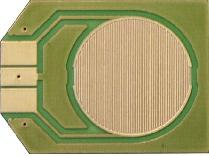Interdigitated Electrodes
In this arrangement, the sample material covers the surface of a comb micro structure electrode.Interdigit electrodes may be used in combination with the BDS1200- or Alpha active sample connection head for temperature dependent measurements or direct connected to the impedance analyzer.
Compared to the parallel plate electrodes, interdigit electrodes are less accurate but easier to handle.
High-quality version: BDS 1410

The figures show two versions of our high-quality interdigit electrodes (Order No. BDS 1410) with 20 mm and 15 mm diameter, respectively. Spacing between the comb fingers and their width is 150 µm, a 75 µm version (only 15 mm diameter) is also available. The center contact is meant to be connected to ground, thereby reducing interference effects due to external electric fields like, e.g., from line power.
For ordering, please specify BDS 1410-<diameter/mm>-<spacing/µm>, e.g., BDS 1410-15-75 for 15 mm diameter and 75 µm spacing. Currently available:
- BDS 1410-15-75
- BDS 1410-15-150
- BDS 1410-20-150
Other dimensions upon request.
Low-cost version: BDS 1411

Low cost versions (Order No. BDS 1411) for one-time use for, e.g., monitoring curing processes, are also available (150 µm spacing, 15 mm or 20 mm diameter).
For ordering, please specify BDS 1411-<diameter/mm>-<spacing/µm>, e.g., BDS 1411-20-150 for 20 mm diameter and 150 µm spacing. Currently available:- BDS 1411-15-150
- BDS 1411-20-150
Other dimensions upon request.
Temperature Range
Interdigit electrodes may be used at temperatures from −160 °C to +250 °C.
Advantages:
- Sample attached only at one side of the electrode, leaving the other side of the sample free for other probes (e.g., optical) to simultaneously observe other materials properties. In addition, sensor applications may probe the electrical properties of samples under the influence of electromagnetic radiation or gases.
- In typical applications, sample thickness does not influence the measured properties.
Drawbacks:
- Measured impedance contains contributions from both sample and interdigit electrode substrate. This might lead to significant errors, especially for low loss/highly insulating samples
- For highly conducting samples measured at high frequencies, the resistance and inductance of the interdigit electrodes represents a significant part of the overall measured impedance. Since this effect is difficult to compensate, the use of interdigit electrodes has a limited frequency and impedance range.
For a full description, see our Dielectrics Newsletter 22 (2006) 5-7
